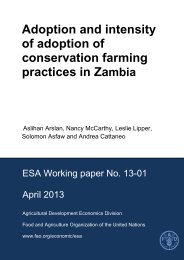Adoption and intensity of adoption of conservation farming practices in Zambia
Adoption and intensity of adoption of conservation farming practices in Zambia
Adoption and intensity of adoption of conservation farming practices in Zambia
Create successful ePaper yourself
Turn your PDF publications into a flip-book with our unique Google optimized e-Paper software.
Table 5. <strong>Adoption</strong> <strong>and</strong> Intensity <strong>of</strong> <strong>Adoption</strong> <strong>of</strong> CF1/CF2 by L<strong>and</strong> Size<br />
L<strong>and</strong><br />
cultivated<br />
(ha)<br />
CF1 CF2<br />
% hh % l<strong>and</strong> % hh % l<strong>and</strong><br />
2004 2008 2004 2008 2004 2008 2004 2008<br />
20 0.25 0.43 0.04 0.05 0.05 0.05 0.03 0.06<br />
Source: Author calculations based on RILS.<br />
Tables 6 <strong>and</strong> 7 present national transition matrices for both def<strong>in</strong>itions <strong>of</strong> CA. Twenty six<br />
percent <strong>of</strong> farmers who did not practice CF1 <strong>in</strong> 2004, had adopted it by 2008, while around<br />
43% <strong>of</strong> adopters <strong>in</strong> 2004 had dis-adopted the practice by 2008. 15 When we use the stricter<br />
def<strong>in</strong>ition <strong>of</strong> CF exclud<strong>in</strong>g h<strong>and</strong> hoe use (CF2), the share <strong>of</strong> new adopters decreases to 5%<br />
<strong>and</strong> that <strong>of</strong> dis-adopters <strong>in</strong>creases to 96%. 16 Fifty eight percent <strong>of</strong> adopters <strong>of</strong> CF1 <strong>in</strong> 2004<br />
were still practic<strong>in</strong>g CF1, whereas this percentage <strong>of</strong> cont<strong>in</strong>u<strong>in</strong>g adopters was only 4% for<br />
CF2. 17<br />
Tables 8 <strong>and</strong> 9 present transition matrices for the Eastern prov<strong>in</strong>ce only. Based on the stricter<br />
def<strong>in</strong>ition <strong>of</strong> CA, a higher proportion <strong>of</strong> farmers became new adopters <strong>and</strong> a smaller<br />
proportion became dis-adopters between 2004 <strong>and</strong> 2008 <strong>in</strong> the Eastern prov<strong>in</strong>ce compared to<br />
the rest <strong>of</strong> the country. The percentage <strong>of</strong> cont<strong>in</strong>u<strong>in</strong>g adopters <strong>of</strong> CF2 are also higher <strong>in</strong> the<br />
Eastern prov<strong>in</strong>ce (12%, though only n<strong>in</strong>e farmers).<br />
Table 6. National Transition Matrix,<br />
CF1<br />
2008<br />
2004 No Yes Total<br />
No # 1,189 424 1,613<br />
% 73.7 26.3 100<br />
Yes # 1,095 1,479 2,574<br />
% 42.5 57.5 100<br />
Table 8. Eastern Prov<strong>in</strong>ce Transition<br />
Matrix, CF1<br />
2008<br />
2004 No Yes Total<br />
No # 231 61 292<br />
% 79.1 20.9 100<br />
Yes # 303 328 631<br />
% 48.1 51.9 100<br />
Source for Tables 6-9: Author calculations based on RILS.<br />
10<br />
Table 7. National Transition Matrix,<br />
CF2<br />
2008<br />
2004 No Yes Total<br />
No # 3,498 165 3,663<br />
% 95.5 4.5 100<br />
Yes # 505 19 524<br />
% 96.4 3.6 100<br />
Table 9. Eastern Prov<strong>in</strong>ce Transition<br />
Matrix, CF2<br />
2008<br />
2004 No Yes Total<br />
No # 725 122 847<br />
% 85.6 14.4 100<br />
Yes # 67 9 76<br />
% 88.2 11.8 100<br />
15<br />
Dis-adopters are def<strong>in</strong>ed as farmers who used a practice <strong>in</strong> 2004 but did not use the same practice <strong>in</strong> 2008.<br />
16<br />
The adjustment for chitemene as expla<strong>in</strong>ed above decreases the nationwide dis-<strong>adoption</strong> rate only to 95%.<br />
17<br />
Kabwe <strong>and</strong> Donovan (2005) report similar dis-<strong>adoption</strong> rates for various CA <strong>practices</strong> <strong>in</strong> their descriptive<br />
study based on the 2000/01 <strong>and</strong> 2002/03 supplemental surveys conducted by the CSO. Chomba (2004),<br />
however, reports much lower <strong>adoption</strong> rates us<strong>in</strong>g the 1999/2000 <strong>and</strong> 2000/01 supplemental surveys. Both <strong>of</strong><br />
these studies are only descriptive.



